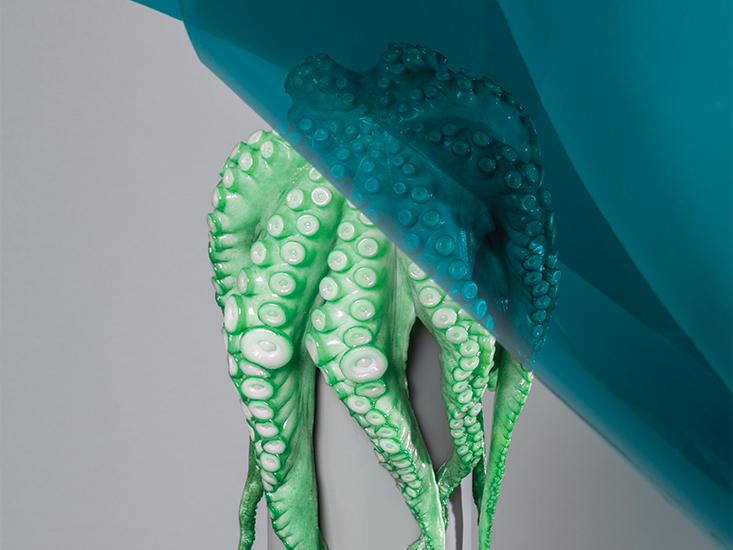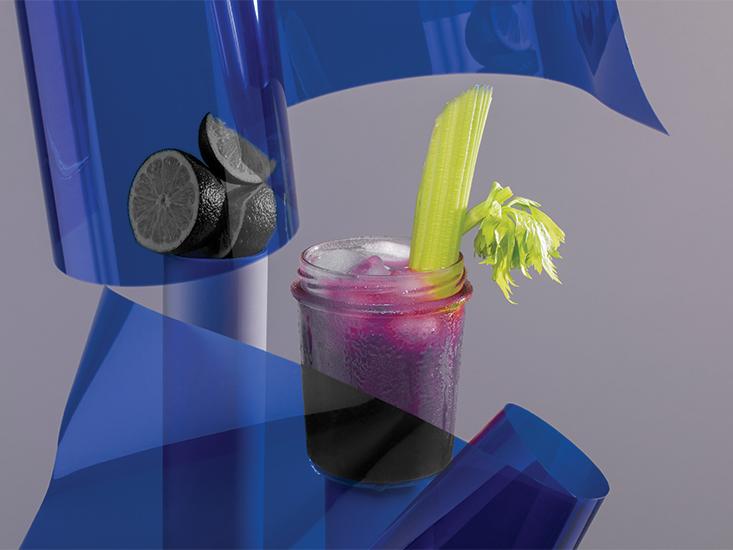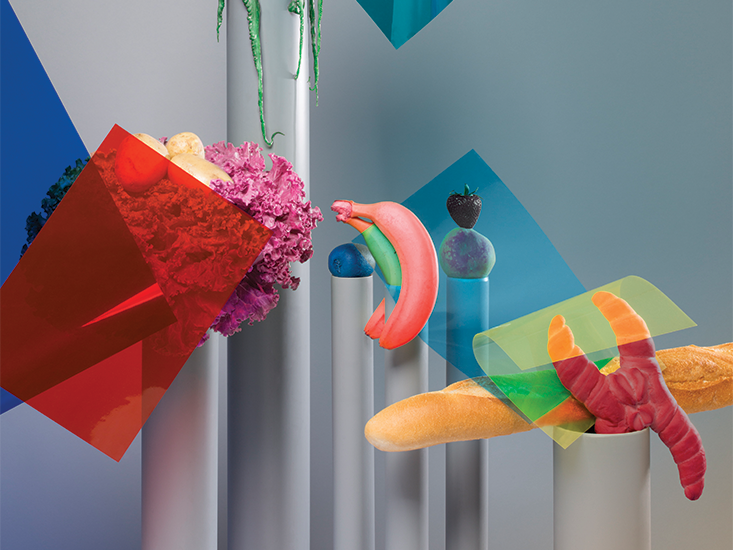When it comes to food, color is money. Food companies scan their products on the line with custom colorimeters to ensure mathematically consistent hues. Fruits and vegetables are shipped in chemically “modified” atmospheres, because “better stem and fruit color gives better prices,” according to the website of the delivery company TransFresh. Color is judged by a legion of standards all along the food chain. The hue of orange juice, for example, is carefully calibrated by the United States Department of Agriculture’s Orange Juice Color Standards (Grade-A orange juice from concentrate has to be “not as good as OJ 5 but much better than OJ 6.”) There are few worse fates, in the eyes of federal regulators, than for a berry to be “undercolored.”
Oranges and berries are just the beginning. The color matching business Munsell sells color standards for French fries, tomatoes, pumpkins, olives, molasses, honey, and cherries. Art Schmehling, a manager with Munsell, tells me a product like the maraschino cherry actually has two color standards: One for the cherry after it is bleached to a pale yellow, which is done so the cherry can be properly dyed its trademark iridescent red; and another for that red.
The attention to color is not just for show: For all the talk of the tongue and palate, our eyes are arguably the most important gustatory organ. As Charles Spence, who heads the Crossmodal Research Laboratory at Oxford University, points out, more than half of our cortical real estate is dedicated to processing vision—just a percent or two is given over to taste faculties (making us rather unique among mammals). The result is not just that color flavors our expectations: It actually changes how we taste food.

In a 1980 study, subjects were blindfolded and asked to tell whether the beverage they were drinking was flavored orange.1 Only one in five could. But when they were allowed to see what they were drinking, each of them identified the orange flavor. And when a lime-flavored drink was colored orange, nearly half of respondents thought it was flavored orange—none did when it was green.
It’s not just the color of the drink that matters. Test subjects thought coffee in a white mug tasted less sweet than in a transparent or blue mug,2 and that 7up had a more lemon-limey taste when more yellow was added to the packaging.3 Even the color of the plate might change our sense of taste: Subjects reported strawberry mousse tasted better on a white round plate than on a black square plate.4
The eyes can deceive even the expert tongue. A study at Cornell University, for example, found that trained experts had trouble distinguishing the fat content of milk when they could not see it; the “whiteness” of milk was a far more important cue than whatever sensations came from actually having it in one’s mouth. “There is nowhere that is safe from expectation,” argues Spence.
Don’t like that wine? Try it under different lighting. Want that drink to taste sweeter? Make its color brighter.
In another well-known study by professor of oenology Wendy Parr and her colleagues, wine experts were asked to describe the odors in two glasses of wine, a chardonnay white and a pinot noir red.5 Unbeknownst to them, a flavorless red food coloring had been added to the white wine. When they sampled the colored white wine in opaque glasses, they were more accurate. In clear glasses, however, they began straying into descriptors more common to red wine; their considerable knowledge of red wine descriptors was triggered by the mere sight of red. Their knowledge was, in a sense, backfiring.
Food companies, which regularly do taste testing internally, know the confusion that color can create. Their trained sensory panelists evaluate new foods under red lighting, so that their powers of discrimination are not thrown off by traditional color-flavor expectations. As Jeannine Delwiche, a sensory scientist at Mead Johnson Nutrition (and before that at Pepsi-co) notes, at the early stages of a food product’s development, “the color often isn’t set.” Changes in the way the food is eventually processed may change its appearance. “The assumption is you can address that separately,” she says. “Meanwhile you want to know how the flavor’s doing.” The red light, she says, compels the panelists to focus more on other attributes, like texture and flavor.

Precisely what is happening when someone misidentifies the flavor of a beverage with an unexpected color? Is it that participants simply cannot fully discern what that flavor is, and so rely on visual cues to help inform their decision? Or does color actually change the experience of the taste?
The key to this question is the effect of color on expectation. “The primary taste cortex is one of the first stops after the tongue,” says Spence. But “even activity there is modulated by your expectations.” Where the thinking used to be, notes Spence, that “all this information comes from outside through our eyes, ears, and tongue and works its way up through the cortical hierarchy, at each stage being condensed, it turns out that there are more pathways going from the inside out.”
The brain acts like a prediction engine: If bright red fruits usually taste sweeter, the next time you eat a fruit that looks bright red a top-down “back projection” might be, as Spence suggests, “constraining the activity earlier in the neural system closer to the outside, to your eye or tongue.”
A 2014 article in the journal Neuropsychologia puts it this way: “expectations bias sensory representations both prior to and during evidence accumulation.” Imaging studies, it notes, “have detected anticipatory signals or ‘baseline shifts’ in sensory regions that are selective for expected stimuli.”6 One of the simplest baseline shifts when it comes to taste is that the brain’s gustatory system “codes” flavor information faster when that flavor matches expectations (color being a major part of that expectation).7 In rats, at least—our fellow omnivores—the mere association with a taste previously experienced seems to stimulate similar “neural ensembles” in the gustatory cortex as does actually experiencing the taste.8
And so, gazing upon a glass of deep red juice, which we are told is made from strawberries, we have a learned association with that flavor and its expected sweetness. A “template” of sweet strawberry taste is activated. Or in the language of the Neuropsychologia study, a “feedforward prediction error signal” issues from the “lowest-level stimulus template.” If the tongue senses a reduced sweetness, a back-and-forth communication between lower and higher order parts of the brain can decide in favor of the reigning idea of a sweet strawberry juice anyway.
We are all born liking sweet things, but we are not born knowing what sweet things look like.
We taste first with the eyes, just as the old saying goes. And the path from color to taste can go in both directions. As an article in the Journal of Dairy Science notes, consumers want cheddar cheese that looks good (the USDA standard is for “medium yellow-orange with a uniform bright color, and an attractive sheen”).9 But if something is not right with the flavor, the “attention of consumers can be drawn to the cheese color.” It may now look wrong because it tastes wrong. In fact, in imaging studies in which subjects’ taste expectations were violated, areas of the visual cortex were suppressed, as if the brain was saying “wait, the eyes are not to believed here.”10
Charles Gilbert, a neurobiologist at Rockefeller University, notes that, even when we are unaware of it, “we are constantly implementing an interaction between top-down influences and input coming from the sensory periphery.” He notes demonstrations (like the McGurk effect) in which subjects watch someone saying different phonemes, even as the audio actually stays the same. The visual guide is enough to make them perceive the different phonemes. “What you hear depends on what you see,” says Gilbert. “We are only now beginning to learn what kind of information is conveyed in a top-down fashion and how top-down influences are manifested at different cortical levels, but I’ll bet that all levels are involved in some way.”
In his book An Anthropologist on Mars, Oliver Sacks tells the story of “Mr. I,” a painter who lost the ability to distinguish colors after a car crash. While he knew the color of things from memory, he no longer saw them. “Tomato juice is black,” he wrote. Over time, these new associations took hold. When he ate, he closed his eyes, “but this did not help very much,” wrote Sacks, “for the mental image of a tomato was as black as its appearance.” In desperation, he began to eat only black and white foods—black olives, yogurt—because these at least looked as they should.
The episode illustrates the flip side of the visual influence over taste: We can use vision to learn to like new tastes. There is little evidence that color-flavor relationships are hard-wired. We are all born liking sweet things, but we are not born knowing what sweet things look like.
The brain, says Spence, “picks up the statistics of the environment,” and we learn, for example, “that fruits go from green and sour and unripe to red and ripe and full of energy.” We do not have to taste a green strawberry to know we will not like its taste.
Sacks’ story hints at how quickly these associations can be changed. As Spence notes, several decades ago, it was a truism in the food industry that you couldn’t sell blue foods, given their rarity in nature. Yet now, shelves bristle with “cool blue” Gatorades and “blue raspberry” Icees. Those associations, he says, were taught—and it helps when the flavor is novel, or indeed invented. Candy and beverages seem particularly amenable to color experimentation, suggests Delwiche. “They are like the evening wear of the food world—not what you wear to the office.” But strange colors have also crept into food marketed to children, where novelty is prized, and learned associations less rigid. Heinz sold many bottles of green, orange, and yes, blue, ketchup in the 2000s, before the novelty ran dry.
If we can learn to like new colors of food, color can also help us learn to like new foods. Tim Geistlinger, vice president of research and development at Beyond Meat, a company making plant-based protein products, notes that consumers are not ready for chlorophyll-tinged hamburgers. “There’s no meat that’s green unless it’s going bad.” So his job, turning green into brown, while technically complex, has a simple end goal: Looking just like the (cooked or raw) meat it is aiming to replace. “It’s got to be very recognizable, or people won’t buy it. That’s their first due diligence.”
Don’t like that wine? Try it under a different kind of lighting. Want that drink to taste sweeter? Make its color brighter. Want your tea to feel colder? Put it into a glass container. Seeing really is believing.

Like an invisible conductor, the brain deftly arranges and synthesizes information coming in from the different senses. As this “multisensory integration” typically feels so seamless, actually glimpsing it at work feels disconcerting, a ripple in the Matrix. Take the red pill, and you find out that vision casts a dominant view over every sense (though it too can be affected, as in a demonstration in which a single flash of light, accompanied by two “beeps,” suddenly looks like two flashes).
In a famous 1964 experiment, the scientists Irvin Rock and Jack Victor had people look at small square objects that had been experimentally manipulated to appear like rectangles. They had others touch the objects with their eyes closed. A third group did both. They were then asked to draw what they experienced. As you might expect, the lookers drew rectangles, while the feelers drew squares. But those who could look and feel drew rectangles.11 Vision, argue the philosophers Dustin Stokes and Stephen Biggs, has an unparalleled, “asymmetric” power over other senses, not least because we seem to rely on mental imagery—“visual cortical processing”—to know what things feel like: “We often invoke visual imagery to learn about certain tactile stimuli, but we rarely, if ever, invoke tactile imagery to learn about visual stimuli.”12
Taste seems so inviolable because it takes place inside of us; like a secret memory, only we can taste what we can taste—how could it betray us? But before food gets to us, our eyes have already seasoned it.
Tom Vanderbilt writes on design, technology, science, and culture, among other subjects.
References
1. DuBose, C.N., Cardello, A.V., & Maller, O. Effects of colorants and flavorants on identification, perceived flavor intensity, and hedonic quality of fruit flavored beverages and cake. Journal of Food Science 45, 1393-1399 (1980).
2. Van Doorn, G., Wuillemin, D., & Spence, C. Does the colour of the mug influence the taste of the coffee? Flavour 3 (2014).
3. Gladwell, M. Blink: The Power of Thinking Without Thinking Back Bay Books, New York, NY (2007).
4. Stewart, P. & Goss, E. Plate shape and colour interact to influence taste and quality judgments. Flavour 2:27 (2013).
5. Parr, W.V., White, K.G., & Heatherbell, D.A. The nose knows: Influence of colour on perception of wine aroma. Journal of Wine Research 14, 79-101 (2013).
6. Dunovan, K.E., Tremel, J.J., & Wheeler, M.E. Prior probability and feature predictability interactively bias perceptual decisions. Neuropsychologia 61, 210- 221 (2014).
7. Samuelsen, C.L., Gardner, M.P.H., & Fontanini, A. Effects of cue-triggered expectation on cortical processing of taste. Neuron 74, 410-422 (2012).
8. Saddoris, M.P., Holland, P.C., & Gallagher, M. Associatively learned representations of taste outcomes activate taste-encoding neural ensembles in gustatory cortex. The Journal of Neuroscience 29, 15386-15396 (2009).
9. Wadhwani, R. & McMahon, D.J. Color of low-fat cheese influences flavor perception and consumer liking. Journal of Dairy Science 95, 2336-2346 (2012).
10. Veldhuzien, M.G., Douglas, D., Aschenbrenner, K., Gitelman, D.R., & Small, D.M. The anterior insular cortex represents breaches of taste identity expectation. The Journal of Neuroscience 31, 14735- 12744 (2011).
11. Rock, I. & Victor, J. Vision and touch: An experimentally created conflict between the two senses. Science 143, 594-596 (1964).
12. Stokes, D. & Biggs, S. The dominance of the visual. In Stokes, D., Matthen, M, & Biggs, S. (Eds.), Perception and Its Modalities Oxford University Press (2014).























